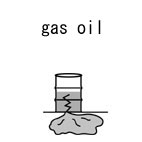| Case Name |
Leakage of gas oil from fuel feed piping of a gas turbine generator at a thermal power plant |
| Pictograph |

|
| Date |
July 7, 1997 |
| Place |
Kawasaki, Kanagawa, Japan |
| Location |
Power plant |
| Overview |
On July 7th, 1997. Operation of a gas turbine generator started after repairs to fuel piping of the gas turbine. A fuel low-pressure alarm sounded, supply of gas oil stopped automatically, and the gas turbine stopped. The gasket of the fuel piping flange was damaged and fuel had leaked. Repairs to another piping were performed simultaneously with the repairs to fuel piping. The cause was a gasket with low resisting pressure was attached by mistake. |
| Incident |
During usual operation of the gas turbine generator of a thermal power plant, about 40 L of gas oil leaked from a flange in fuel piping, and it spread to a radius of about 10 m. |
| Processing |
Consumption and usage |
| Substance |
Gas oil |
| Type of Accident |
Leakage |
| Sequence |
On April 7th, 1997. Repairs to a gas turbine burner and an oil cooler were performed simultaneously. In the burner, gaskets of fuel atomizing piping and water atomizing piping were replaced. In the oil cooler, the gasket of a fin-fan cooler was replaced.
The group leader of the subcontractor directed a worker specializing in water atomizing piping to attach the gasket, and left the site.
The supervisor of the prime contractor was not at the site. The worker attached the gasket to water atomizing piping.
On July 7th. Operation of a gas turbine generator started.
15:43 on July 7th. A low-pressure of fuel alarm sounded during usual operation. The gas turbine stopped automatically by automatic closing of the fuel cut-off valve and stopping of the fuel pump.
15:46. Leakage of fuel was found at the site.
16:13. Leakage was notified to the public fire department by an emergency call.
16:25. The block valve of fuel feed piping was closed and immediate action was completed. |
| Cause |
Although asbestos sheet packing should have been used for the flange of 6.0 MPaG fuel piping, rubber sheet packing (1.0 MPaG in specifications) was used by mistake. Therefore, the gasket was damaged by the pressure of usual operation.
Three repairs were performed in parallel and three different kinds of gasket were not arranged.
Although the worker had knowledge about the gasket attachment method, he had no knowledge of gasket selection.
As the gasket to be used was not directed, the worker made a choice at his option. |
| Response |
Closed a cut-off valve. Stopped fuel supply. Notified fire department. Closed a block valve. |
| Countermeasures |
Establishment of a repair management system is a top priority.
Workers' safety education.
Classification and management of consumables. |
| Knowledge Comment |
During two or more simultaneous repairs, it is very easy to make mistakes. Simultaneous work should be avoided if possible.
If it is necessary to carry out repairs simultaneously, sufficient preventive measures for mistakes are required. |
| Background |
The accident is considered to be caused due to a mistake in repair management. On performing two or more construction tasks at the same place, materials must be separated clearly and work procedure must be defined. However, these measures were neglected.
The supervisor of the prime contractor or the group leader of the subcontractor should direct how to use a gasket. However, the worker was not directed. There was a lack of attention because it was accustomed work.
All work was left to the subcontractors because the owner thought that the result of the repair would not be related to the quality of products.
Considering that all results of repairs return to the owner side, establishing a repair management system should be a duty of the owner. |
| Reason for Adding to DB |
Example of leakage caused due to simultaneous parallel work |
| Scenario |
| Primary Scenario
|
Organizational Problems, Poor Management, Slackness of Management, Poor Value Perception, Poor Safety Awareness, Inadequate Risk Recognition, Planning and Design, Poor Planning, Poor Repair Management Planning, Usage, Maintenance/Repair, Repair, Failure, Fracture/Damage, Gasket Leak, Secondary Damage, External Damage, Fire
|
|
| Sources |
Kawasaki City Fire fighting station, Prevention division, Peace section, Gas oil leakage from fuel supply piping to gas turbine generator at K power plant, T electric power Co., Ltd. Material of the Kawasaki City Complex safety countermeasures committee (1997).
|
| Physical Damage |
About 40 L of gas oil |
| Field |
Chemicals and Plants
|
| Author |
ITAGAKI, Haruhiko (Japan National Institute of Occupational Safety and Health)
TAMURA, Masamitsu (Center for Risk Management and Safety Sciences, Yokohama National University)
|
|